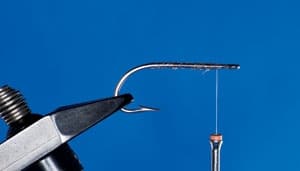
The other day I was rummaging through the closet and found my first fly rod. It was an old, two-piece glass Fenwick rod that my father built for me when I was 8 years old. I remember a couple of things about this rod. First is getting so frustrated – after a week of flailing on the shallow flats of east central Florida’s Banana River behind my parents’ tackle shop – that I put it away for more than a year before finally picking it back up.
My fondest memory, however, was the first fish I ever caught on fly. It was a spotted seatrout that weighed all of about 2 pounds. I also remember the fly I caught it on – a 2/0 yellow-and-white Brooks’ Honey Blonde. It is a simple pattern that has served me – and generations of freshwater and saltwater fly-fishers – well.
Although Joe Brooks is generally credited as the originator of the Blonde, it was actually developed by Richmond fly tier Bill Gallasch. Brooks popularized the fly and showed how versatile it could be by taking everything from world-record stripers in North America to tigerfish in Africa to brown trout in Argentina.
“Joe didn’t invent that fly, but he sure made it famous,” says Lefty Kreh. “You know, when he was fishing back in the ’40s and ’50s, if you wanted to go on an exotic trip, you went to Canada. Joe was traveling places and catching all sorts of exotic species, and the Blonde was one of his most productive patterns.”
The Blonde was likely the first hi-tie style fly. Even though the tail wasn’t tied using that unique, elevated style, the wing was – and it led to a host of other permutations in the ensuing years.
The original version of the pattern was referred to as the Argentine Blonde and featured a white tail, shank wrapped with mylar tinsel and a blue wing. The tail is actually laid down the length of the hook shank, otherwise the mylar wouldn’t wrap evenly. The only real limitation when tying this pattern is your imagination.
“One thing tiers might want to do is coat the body with head cement,” says Kreh. “Although it doesn’t happen too much with our materials today, that tinsel back then used to corrode after a couple of days of fishing. But if you do coat the body with head cement, it will also make the fly more durable.”
I’ve made two personal tweaks to the pattern. First, rather than using mylar, I prefer several strands of Lateral Scale. When wrapped forward, the strands spread out, filling any gaps in between; also, because Lateral Scale is nonmetalic, it won’t corrode. Secondly, to make the fly ultra-durable, I coat the wrapped body with epoxy, making it perfect for toothy critters like mackerel and bluefish.
The Blonde series of flies is one of the simplest patterns we can include in our arsenal – and at the same time is one of the most effective. No matter what I’m fishing for, you can bet that there will be couple of Blondes in my fly box.
**Materials
Hook:** Mustad 34007, No. 4 to 3/0
Thread: Clear monofilament
Tail and wing: Long, straight bucktail, underfur removed, color as desired.
Body: Several strands of Lateral Scale, color as desired.
Glue: Five-minute epoxy
Eyes: Optional
| Step 1: Tie a base of thread from behind the eye to the bend of the hook and coat with head cement. This will serve as a solid base for the tail and prevent the fly from torquing. |
| ** |
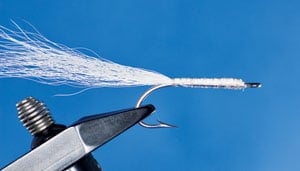
Step 2:** Take a clump of long, white bucktail about the diameter of a pencil. Holding it at the tips, use your fingers to knock out any of the underfur or shorter hairs, leaving the longest, straightest fibers. Tie in about 1/16 of an inch behind the hook and wrap towards the hook bend.| | **
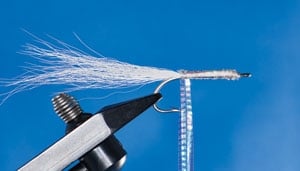
Step 3:** Tie in several strands of pearlescent Lateral Scale at the hook bend. Wrap forward, creating a body, to within 1/16 of an inch from the hook eye. Tie off and cut.| | **
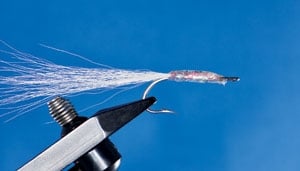
Step 4:** Coat the Lateral Scale with epoxy and rotate until cured.| | **
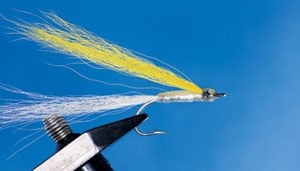
Step 5:** Using the same procedure in Step 2, tie in a bucktail wing just ahead of the Lateral Scale/epoxy body. Form a small, bullet-shaped head and then whip finish. If desired, apply a small, mylar eye on each side. Coat head with epoxy and rotate until cured.|









